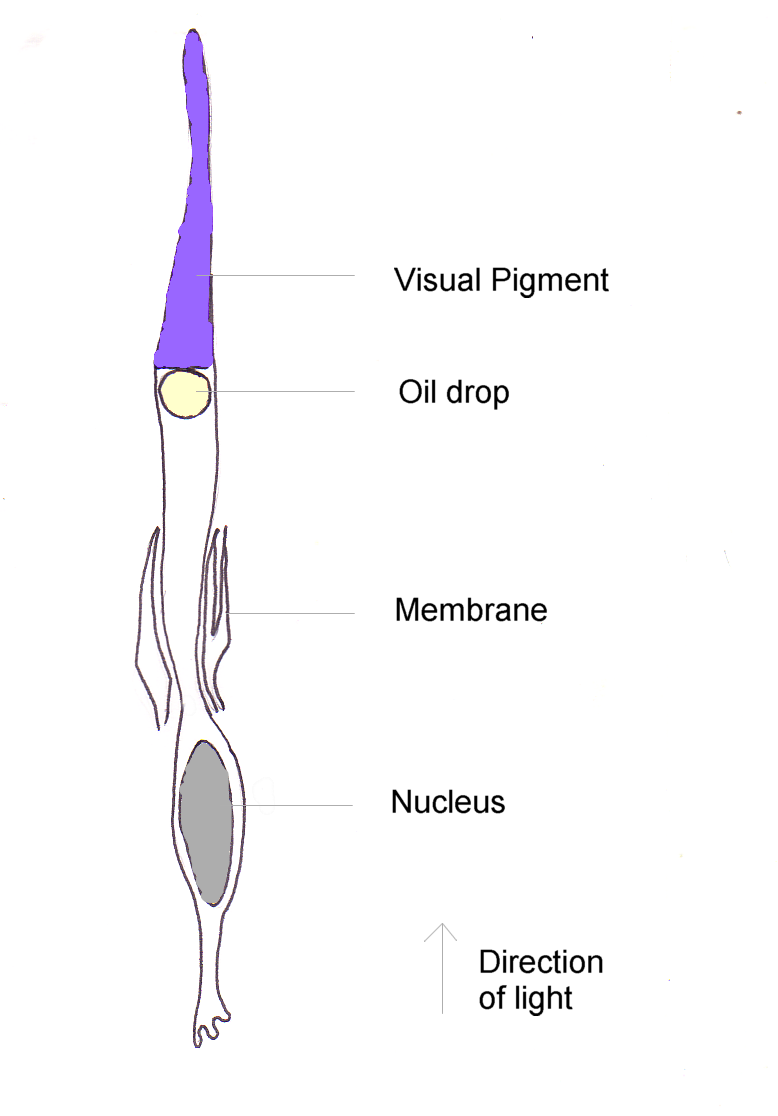Oil droplet on:
[Wikipedia]
[Google]
[Amazon]
 Oil droplets are found in the eyes of some animals, being located in the
Oil droplets are found in the eyes of some animals, being located in the
 Oil droplets are found in the eyes of some animals, being located in the
Oil droplets are found in the eyes of some animals, being located in the photoreceptor cell
A photoreceptor cell is a specialized type of neuroepithelial cell found in the retina that is capable of visual phototransduction. The great biological importance of photoreceptors is that they convert light (visible electromagnetic radiat ...
s. They are especially common in the eyes of diurnal (active during the day) reptile
Reptiles, as most commonly defined are the animals in the class Reptilia ( ), a paraphyletic grouping comprising all sauropsids except birds. Living reptiles comprise turtles, crocodilians, squamates ( lizards and snakes) and rhynchocephalia ...
s (e.g. lizard
Lizards are a widespread group of squamate reptiles, with over 7,000 species, ranging across all continents except Antarctica, as well as most oceanic island chains. The group is paraphyletic since it excludes the snakes and Amphisbaenia altho ...
s, turtle
Turtles are an order of reptiles known as Testudines, characterized by a special shell developed mainly from their ribs. Modern turtles are divided into two major groups, the Pleurodira (side necked turtles) and Cryptodira (hidden necked t ...
s) and bird
Birds are a group of warm-blooded vertebrates constituting the class Aves (), characterised by feathers, toothless beaked jaws, the laying of hard-shelled eggs, a high metabolic rate, a four-chambered heart, and a strong yet lightweig ...
s (see bird vision
Vision is the most important sense for birds, since good eyesight is essential for safe flight. Birds have a number of adaptations which give visual acuity superior to that of other vertebrate groups; a pigeon has been described as "two eyes with ...
), though are present in other taxa such as lungfish
Lungfish are freshwater vertebrates belonging to the order Dipnoi. Lungfish are best known for retaining ancestral characteristics within the Osteichthyes, including the ability to breathe air, and ancestral structures within Sarcopterygii, i ...
. They are found in cone cell
Cone cells, or cones, are photoreceptor cells in the retinas of vertebrate eyes including the human eye. They respond differently to light of different wavelengths, and the combination of their responses is responsible for color vision. Cone ...
s far more often than in rods, suggesting a role in colour vision
Color vision, a feature of visual perception, is an ability to perceive differences between light composed of different wavelengths (i.e., different spectral power distributions) independently of light intensity. Color perception is a part of ...
. Occurrence in rod cells may imply that they have been modified from a cone cell ancestor. They occasionally occur in double cones/double rods. Some oil droplets are colour
Color (American English) or colour (British English) is the visual perceptual property deriving from the spectrum of light interacting with the photoreceptor cells of the eyes. Color categories and physical specifications of color are associ ...
ed, while others appear colourless. They are located in the cone inner segment, where they intercept and filter light
Light or visible light is electromagnetic radiation that can be perceived by the human eye. Visible light is usually defined as having wavelengths in the range of 400–700 nanometres (nm), corresponding to frequencies of 750–420 t ...
before it can pass through to the cone outer segment where the opsin
Animal opsins are G-protein-coupled receptors and a group of proteins made light-sensitive via a chromophore, typically retinal. When bound to retinal, opsins become Retinylidene proteins, but are usually still called opsins regardless. Most ...
s are, the molecules that sense light.
The adaptive advantage of oil droplets is not firmly established. Coloured oil droplets have a cost in that they reduce the amount of light available to the visual system
The visual system comprises the sensory organ (the eye) and parts of the central nervous system (the retina containing photoreceptor cells, the optic nerve, the optic tract and the visual cortex) which gives organisms the sense of sight (th ...
. They also reduce the overlap in spectral sensitivity
Spectral sensitivity is the relative efficiency of detection, of light or other signal, as a function of the frequency or wavelength of the signal.
In visual neuroscience, spectral sensitivity is used to describe the different characterist ...
between different types of cone (e.g. short wavelength
In physics, the wavelength is the spatial period of a periodic wave—the distance over which the wave's shape repeats.
It is the distance between consecutive corresponding points of the same phase on the wave, such as two adjacent crests, tr ...
sensitive, medium wavelength sensitive etc.). This can be a benefit because it increases the number of colours that can be discriminated, and calculations by Vorobyev (2003) support the hypothesis that this is of net benefit.
References
{{reflist Color Human eye anatomy